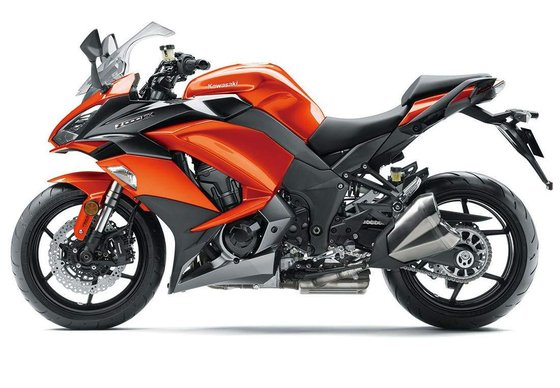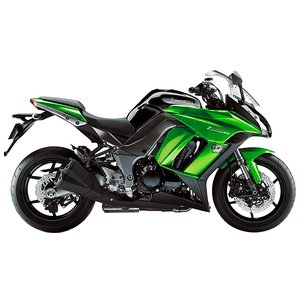Kawasaki Z 1000 SX Ninja [2017-2019] Review: The Sport-Touring Contender That Packs a Punch

Introduction
The Kawasaki Z 1000 SX Ninja (known as the Ninja 1000 ABS in the U.S.) isn’t just a motorcycle—it’s a statement. Built for riders who refuse to compromise between adrenaline-fueled performance and real-world practicality, this 2017-2019 generation strikes a rare balance in the sport-touring segment. Kawasaki’s updates during this period transformed it from a competent machine into a polished, tech-savvy tour de force. After spending days slicing through mountain passes and cruising highways, here’s why this bike deserves your attention—and why it might just deserve a spot in your garage.
Design & Ergonomics: Where Aggression Meets Comfort

The Z 1000 SX Ninja’s design screams “sportbike” at first glance, with its sharp lines, dual LED headlights (40% brighter than previous models), and a muscular stance. But look closer, and the touring DNA becomes apparent. The adjustable windscreen—a 2017 upgrade—is a game-changer. At its highest setting, it deflects windblast efficiently, making highway slogs feel like a breeze. The seat, redesigned for this generation, offers a plush yet supportive perch, with a 815-820 mm seat height (32.1-32.3 inches) that accommodates shorter riders without cramping taller ones.
Color options like Candy Lime Green/Metallic Spark Black and Candy Plasma Blue ensure it stands out in a parking lot, while the aluminum twin-tube frame keeps the profile sleek. The revised pannier system is another win—it’s intuitive to clip on/off, and the bags integrate seamlessly with the bike’s lines.
Engine & Performance: The Sweet Spot of Power Delivery
At the heart of the Z 1000 SX Ninja lies a 1,043cc inline-four engine that’s been Euro 4-compliant since 2017. With 142 HP (105 kW) at 10,000 RPM and 111 Nm (81.9 lb-ft) of torque peaking at 7,300 RPM, this mill is a master of duality. Below 5,000 RPM, it’s docile enough for city commutes, with smooth throttle response from the 38mm throttle bodies. But crack the throttle open, and the engine transforms—howling to its 10,500 RPM redline with a ferocity that’ll pin you to the seat.
The slipper clutch (lighter pull than earlier models) pairs perfectly with the 6-speed gearbox, enabling quick downshifts without rear-wheel chatter. Kawasaki’s decision to stick with a chain final drive pays off here—it’s low-maintenance and transmits power efficiently, even if it lacks the belt’s silence.
Ride Experience: A Chameleon on Twisty Roads
This isn’t a hyper-focused sportbike, nor is it a lazy tourer. The Z 1000 SX Ninja thrives in the middle ground. The 41mm inverted forks and Horizontal Back-link rear suspension offer plush compliance over rough pavement, yet stiffen up predictably when you attack corners. With a 1435-1445 mm wheelbase (56.5-56.9 inches) and 235 kg (518 lbs) wet weight, it feels nimble for its size—flickable enough for tight switchbacks but stable at triple-digit speeds.
Braking is equally impressive. The dual 300mm front discs with radial-mount monobloc calipers deliver eye-widening stopping power, aided by cornering ABS that’s nearly invisible in operation. Kawasaki’s KTRC traction control (with three modes) adds confidence in wet conditions, though Mode 1 is lenient enough for spirited riding.
Technology & Electronics: Smarter Than It Lets On
The 2017 update brought a suite of modern tech. The 4.3-inch TFT display is intuitive, showing gear position, fuel economy, and traction control status. Ride modes (Full Power, Low Power, and Rain) alter throttle response and power output, though even in Rain mode, there’s enough grunt to overtake traffic.
But the star is the Inertial Measurement Unit (IMU). By monitoring pitch, roll, and yaw, it enables cornering-aware ABS and traction control—a rarity in this price bracket. The system isn’t as granular as Ducati’s latest offerings, but it’s far from intrusive.
Competition: How It Stacks Up
Yamaha Tracer 900 GT
The Tracer’s CP3 triple is a joy, with its torquey low-end and howling exhaust. It’s lighter (215 kg / 474 lbs) and more frugal, but the Z 1000 SX’s inline-four offers superior top-end rush and a richer tech package. The Tracer’s suspension also feels budget-oriented compared to Kawasaki’s adjustable setup.
Suzuki GSX-S1000F
Suzuki’s liter-class contender matches the Z 1000 SX in power but skimps on electronics—no IMU, no cornering ABS. Its riding position is more aggressive, making long rides a chore. The Kawasaki’s luggage-ready design and taller windscreen give it the touring edge.
Honda VFR800F
Honda’s V4 is silky-smooth and the VFR’s build quality is impeccable. However, its 108 HP output feels dated next to the Z 1000 SX, and the lack of adjustable suspension hurts its versatility.
Verdict: The Z 1000 SX Ninja outguns rivals in tech and flexibility, though riders prioritizing lightweight agility might prefer the Tracer.
Maintenance: Keeping the Beast Happy
The Z 1000 SX Ninja is relatively low-maintenance, but a few key points will ensure longevity:
- Oil Changes: Use SAE 10W-40 (3.8L with filter). MOTOPARTS.store offers synthetic kits with OEM-spec filters.
- Chain Care: The sealed chain needs cleaning every 500 km (310 miles). Our store’s chain cleaning kits include a rust inhibitor.
- Tire Pressures: 2.5 bar (36 psi) front / 2.9 bar (42 psi) rear. Stick to these for optimal grip and wear.
- Coolant: Kawasaki recommends replacing coolant every 2 years. Our pre-mixed ethylene glycol coolant meets factory specs.
- Brake Fluid: Flush with DOT 4 annually. Check our selection of high-temperature-resistant fluids.
Pro Tip: The NGK CR9EIA-9 spark plugs (gap 0.8-0.9 mm) should be replaced every 12,000 km (7,500 miles). Our iridium plugs last longer and improve cold starts.
Conclusion: The All-Rounder That Still Thrills
The 2017-2019 Kawasaki Z 1000 SX Ninja is a rare breed—a bike that’s equally at home carving canyons, commuting in traffic, or devouring cross-country miles. Its updates during this generation (cornering ABS, IMU, adjustable windscreen) addressed nearly every flaw of its predecessors, cementing its status as a sport-touring benchmark. While it’s not the lightest or most exotic option, few bikes in its class deliver this much character, tech, and versatility in one package.
Whether you’re upgrading suspension, adding luggage, or just keeping it stock, MOTOPARTS.store has the OEM and aftermarket parts to elevate your ride. After all, every Ninja deserves sharp claws.
Specifications sheet
| Engine | |
|---|---|
| Stroke: | Four-stroke |
| Max power: | 103 kW | 138.0 hp |
| Max torque: | 111 Nm |
| Fuel system: | DFI 4 x 38 mm with oval sub-throttles |
| Max power @: | 10000 rpm |
| Displacement: | 1043 ccm |
| Fuel control: | DOHC |
| Max torque @: | 7300 rpm |
| Bore x stroke: | 77.0 x 56.0 mm (3.0 x 2.2 in) |
| Configuration: | Inline |
| Cooling system: | Liquid |
| Compression ratio: | 11.8:1 |
| Number of cylinders: | 4 |
| Valves per cylinder: | 4 |
| Features | |
|---|---|
| ABS: | Cornering ABS with IMU |
| Lighting: | LED headlights |
| Panniers: | Revised attachment system |
| Warranty: | 24 months unlimited kilometers |
| Windscreen: | Adjustable |
| Power modes: | Selectable |
| Instrumentation: | Digital display |
| Traction control: | Selectable modes |
| Dimensions | |
|---|---|
| Wheelbase: | 1445 mm (56.9 in) |
| Wet weight: | 235 |
| Seat height: | 815-820 mm (32.1-32.3 in) |
| Overall width: | 790 mm (31.1 in) |
| Overall height: | 1170 mm (46.1 in) |
| Overall length: | 2105 mm (82.9 in) |
| Ground clearance: | 135 mm (5.3 in) |
| Fuel tank capacity: | 19.0 L (5.02 US gal) |
| Drivetrain | |
|---|---|
| Final drive: | chain |
| Chain length: | 118 |
| Transmission: | 6-speed, wet multi-disc clutch |
| Rear sprocket: | 47 |
| Front sprocket: | 15 |
| Maintainance | |
|---|---|
| Rear tire: | 190/50-z-17 |
| Engine oil: | 10W40 |
| Front tire: | 120/70-z-17 |
| Brake fluid: | DOT 4 |
| Spark plugs: | NGK CR9EIA-9 |
| Spark plug gap: | 0.8-0.9 mm |
| Coolant capacity: | 2.9 |
| Lubrication system: | Forced lubrication, wet sump |
| Engine oil capacity: | 3.8 |
| Engine oil change interval: | Every 5000 km or 2 years |
| Valve clearance check interval: | 24,000 km / 15,000 mi |
| Recommended tire pressure (rear): | 2.9 bar (42 psi) |
| Recommended tire pressure (front): | 2.5 bar (36 psi) |
| Chassis and Suspension | |
|---|---|
| Frame: | Aluminium twin-tube |
| Trail: | 102 mm (4.0 in) |
| Rear brakes: | Single 250 mm disc, single-piston caliper, ABS |
| Front brakes: | Dual 310 mm floating discs, radial-mount 4-piston calipers, ABS |
| Rear suspension: | Horizontal Back-link monoshock, stepless rebound damping, remote preload adjustable |
| Front suspension: | 41 mm inverted fork, stepless compression/rebound damping, preload adjustable |
| Rake (fork angle): | 24.5° |
| Rear wheel travel: | 144 mm (5.7 in) |
| Front wheel travel: | 120 mm (4.7 in) |



















